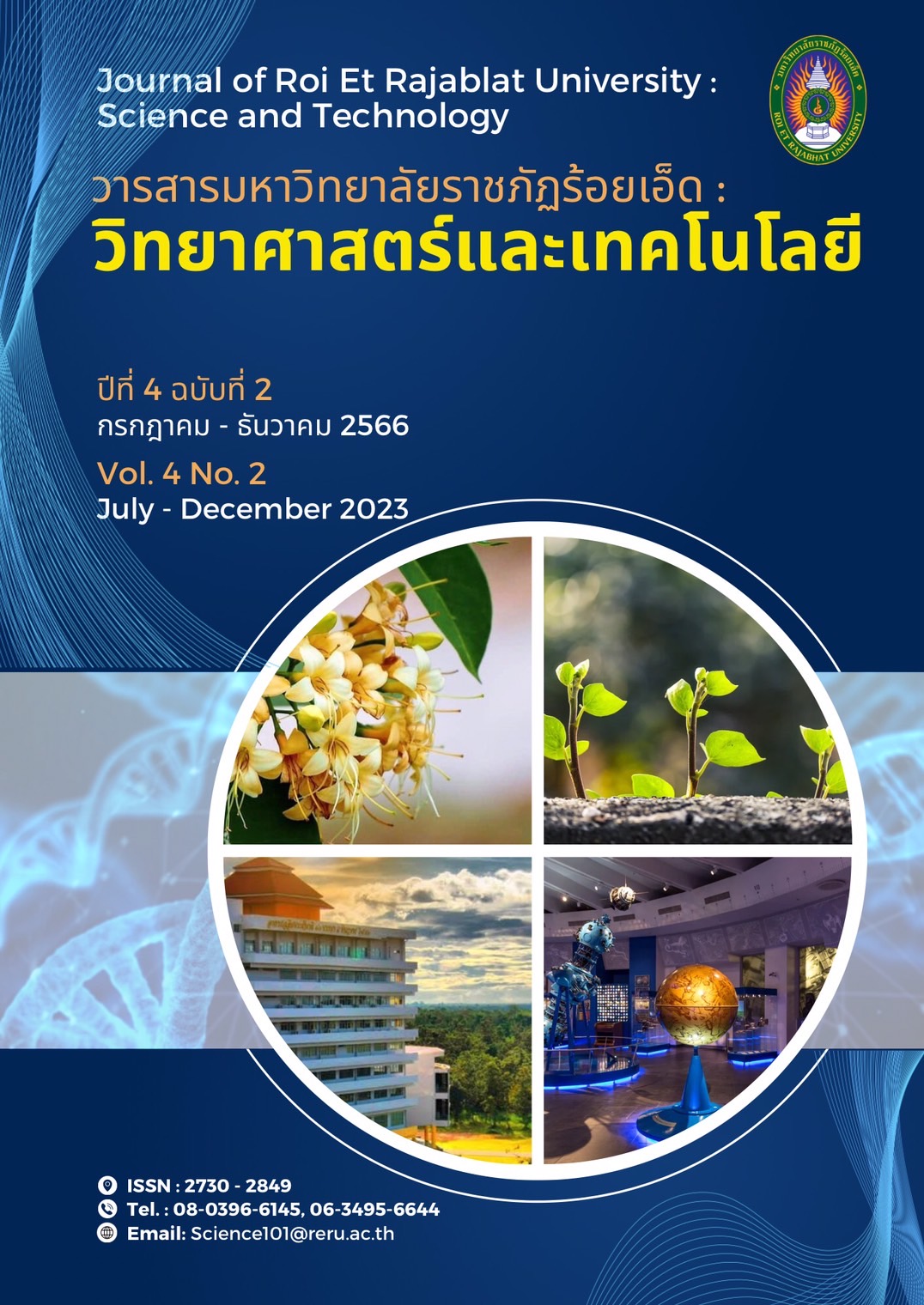Feasibility study of cassava rhizome and coconut shell charcoal for development as adsorption charcoal
คำสำคัญ:
ถ่านดูดซับ, เหง้ามันสำปะหลัง, กะลามะพร้าว, โครงสร้างรูพรุนบทคัดย่อ
Charcoal, besides being used as fuel It is also used as adsorption charcoal and hygroscopic charcoal. Most agricultural biomass residues are suitable to be developed into sorbent charcoal because of biomass has carbon as the main component and a high amount of cellulose. In the process of combustion, makes the pores of biomass charcoal increase. The pores of biomass charcoal are another factor that affects the adsorption ability. This research objective, feasibility study of cassava rhizome and coconut shell charcoal for development as adsorption charcoal. Cassava rhizomes and coconut shells are dried and fired in 200-liter drums. After that, the charcoal was ground and sieved using a sieve with a size of 600 micrometers. The charcoal powder was analyzed for physical properties including surface area, porous structure and density. The charcoal powder was analyzed by the proximate analysis including moisture, ash, volatile matter and fixed carbon content. It was found that both types of biomasses after combustion, it has a rough surface and an increased amount of external and internal pore structures. Due to the breakdown of hemicellulose and cellulose in the combustion process. In addition, it was found that both types of biomasses had decreased moisture content after the combustion process, with values within the standard criteria for activated carbon industry products. Moreover, the ash content and volatile matter content of coconut shell charcoal is lower than that of cassava rhizome charcoal. As a result, coconut shell charcoal has higher rough surface area and pore. While, the fixed carbon content of coconut shells charcoal is higher than cassava charcoal which indicate the amount of carbon with high purity. Therefore, the both types of biomasses have suitable properties and possible for development into adsorption charcoal.
เอกสารอ้างอิง
รัชพล พะวงศ์รัตน์. (2558). กระบวนการปรับสภาพเพื่อเพิ่มประสิทธิภาพการผลิตเอทานอลจากวัสดุเหลือทิ้งทางการเกษตร ประเภทลิกโนเซลลูโลส. สาขาวิทยาศาสตร์และเทคโนโลยี ปีที่ 2 ฉบับที่ 1 เดือนมกราคม-มิถุนายน 2558 : มหาวิทยาลัยเกษตรศาสตร์.
สำนักงานมาตรฐานผลิตภัณฑ์ชุมชน. (2560). คุณภาพถ่านไม้. สืบค้น เมื่อวันที่ 5 ธันวาคม 2566, จาก https://www.tisi.go.th/index.php
ชัยยศ ตั้งสถิตกุลชัย. (2542). การผลิตถ่านกัมมันต์จากถ่านหินลิกไนท์. ภาควิชาวิศวกรรมเคมี สำนักวิชาวิศวกรรมศาสตร์ : มหาวิทยาลัยเทคโนโลยีสุรนารี.
สำนักงานมาตรฐานผลิตภัณฑ์อุตสาหกรรม กระทรวงอุตสาหกรรม. (2560). มาตรฐานผลิตภัณฑ์ชุมชน ถ่านดูดกลิ่น. สืบค้น เมื่อวันที่ 5 ธันวาคม 2566, จาก http://tcps.tisi.go.th/
ธีรดิตถ์ โพธิตันติมงคล.(2560). ถ่านกัมมันต์จากวัสดุเหลือใช้ทางการเกษตรโดยการกระตุ้นทางเคมีเพื่อการประยุกต์ใช้กำจัด สารมลพิษในน้ำ. วารสารหน่วยวิจัยวิทยาศาสตร์ เทคโนโลยีและสิ่งแวดล้อม เพื่อการเรียนรู้ ปีที่ 8 ฉบับที่ 1 มหาวิทยาลัยราชภัฏสมเด็จเจ้าพระยา.
Agunsoye, J.O., Talabi, S.I., Bello, S.A. and Awe, I.O. (2014). The Effects of Cocos Nucifera (Coconut Shell) on the Mechanical and Tribological Properties of Recycled Waste Aluminum Can Composites. Tribology in Industry. 36(2):155-162.
Bhadusha N and Ananthabaskaran T. (2011). Adsorptive removal of methylene blue onto ZnCl2 activated carbon from wood apple outer shell: kinetics and equilibrium studies. E-Journal of Chemistry. 8(4): 1696–707.
Demiral, I. and Ayan, E. A. (2011). Pyrolysis of grape bagasse: Effect of pyrolysis conditions on the product yields and characterization of the liquid product. Bioresource Technology. 102(4): 3946–3951.
Ersan, G., Apul, O. G., Perreault, F. and Karanfil, T. (2017). Adsorption of organic contaminants by graphene nanosheets: A review. Water Research. 126, 385–398.
Mopoung, S., Sirikulkajorn, A., Dummun, D. and Luethanom P. (2012). Nanocarbonfibril in rice flour charcoal. International Journal of the Physical Sciences. 7 (2): 214 -221
Oscar D. Caicedo-Salcedo, Diana P. Vargas-Delgadillo, Liliana Giraldo and Juan Carlos Moreno-Pirajan. (2019). Data of preparation and characterization of activated carbon using two activate agents and mango seed as precursor material. Data in brief. 27: 104769.
ดาวน์โหลด
เผยแพร่แล้ว
รูปแบบการอ้างอิง
ฉบับ
ประเภทบทความ
สัญญาอนุญาต
ลิขสิทธิ์ (c) 2023 คณะศิลปศาสตร์และวิทยาศาสตร์ มหาวิทยาลัยราชภัฏร้อยเอ็ด

อนุญาตภายใต้เงื่อนไข Creative Commons Attribution-NonCommercial-NoDerivatives 4.0 International License.
บทความที่ได้รับการตีพิมพ์เป็นลิขสิทธิ์ของคณะศิลปศาสตร์และวิทยาศาสตร์ มหาวิทยาลัยราชภัฏร้อยเอ็ด
ข้อความที่ปรากฏในบทความแต่ละเรื่องในวารสารวิชาการเล่มนี้เป็นความคิดเห็นส่วนตัวของผู้เขียนแต่ละท่านไม่เกี่ยวข้องกับมหาวิทยาลัยราชภัฎร้อยเอ็ด และคณาจารย์ท่านอื่นๆในมหาวิทยาลัยฯ แต่อย่างใด ความรับผิดชอบองค์ประกอบทั้งหมดของบทความแต่ละเรื่องเป็นของผู้เขียนแต่ละท่าน หากมีความผิดพลาดใดๆ ผู้เขียนแต่ละท่านจะรับผิดชอบบทความของตนเองแต่ผู้เดียว






